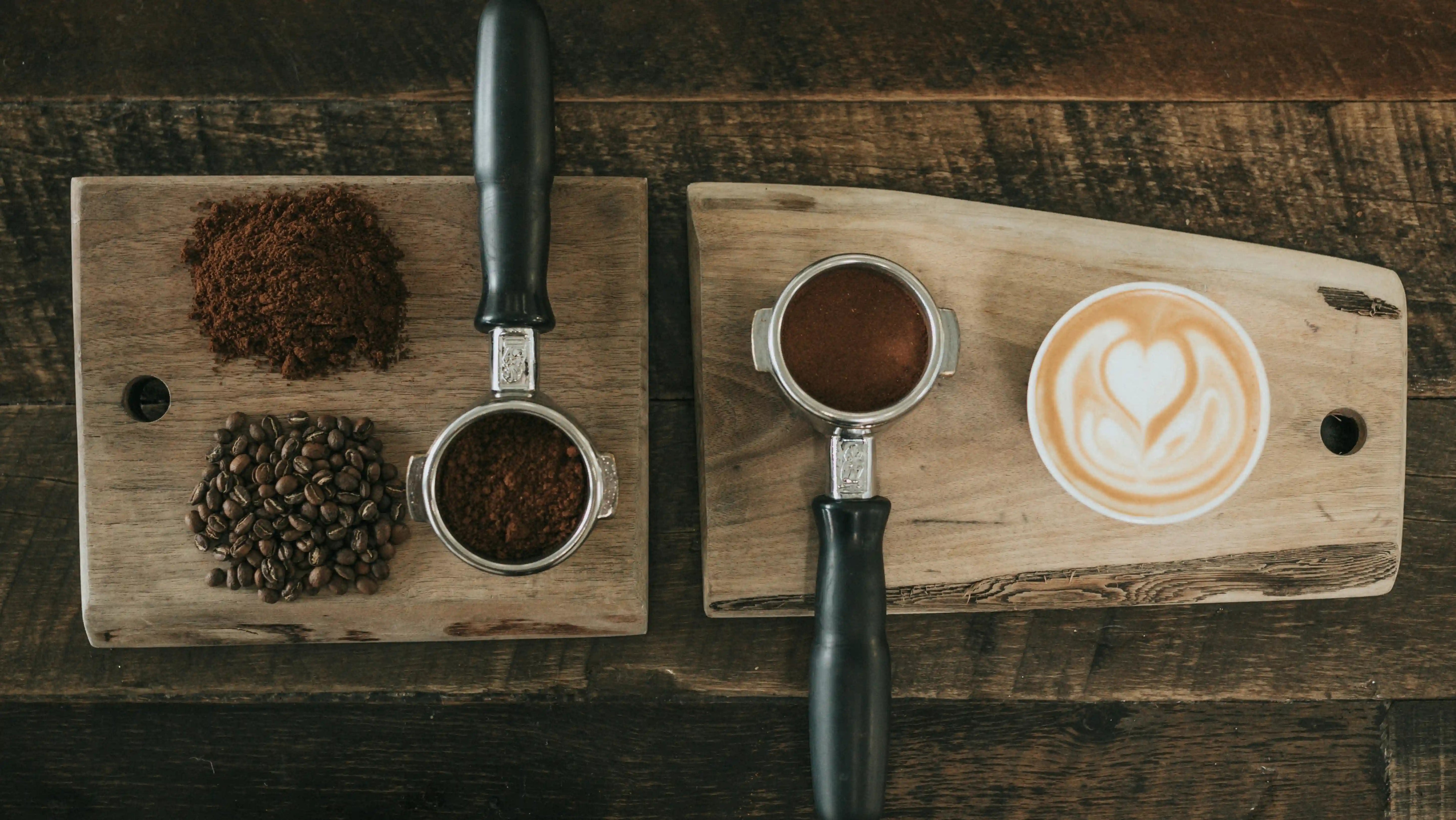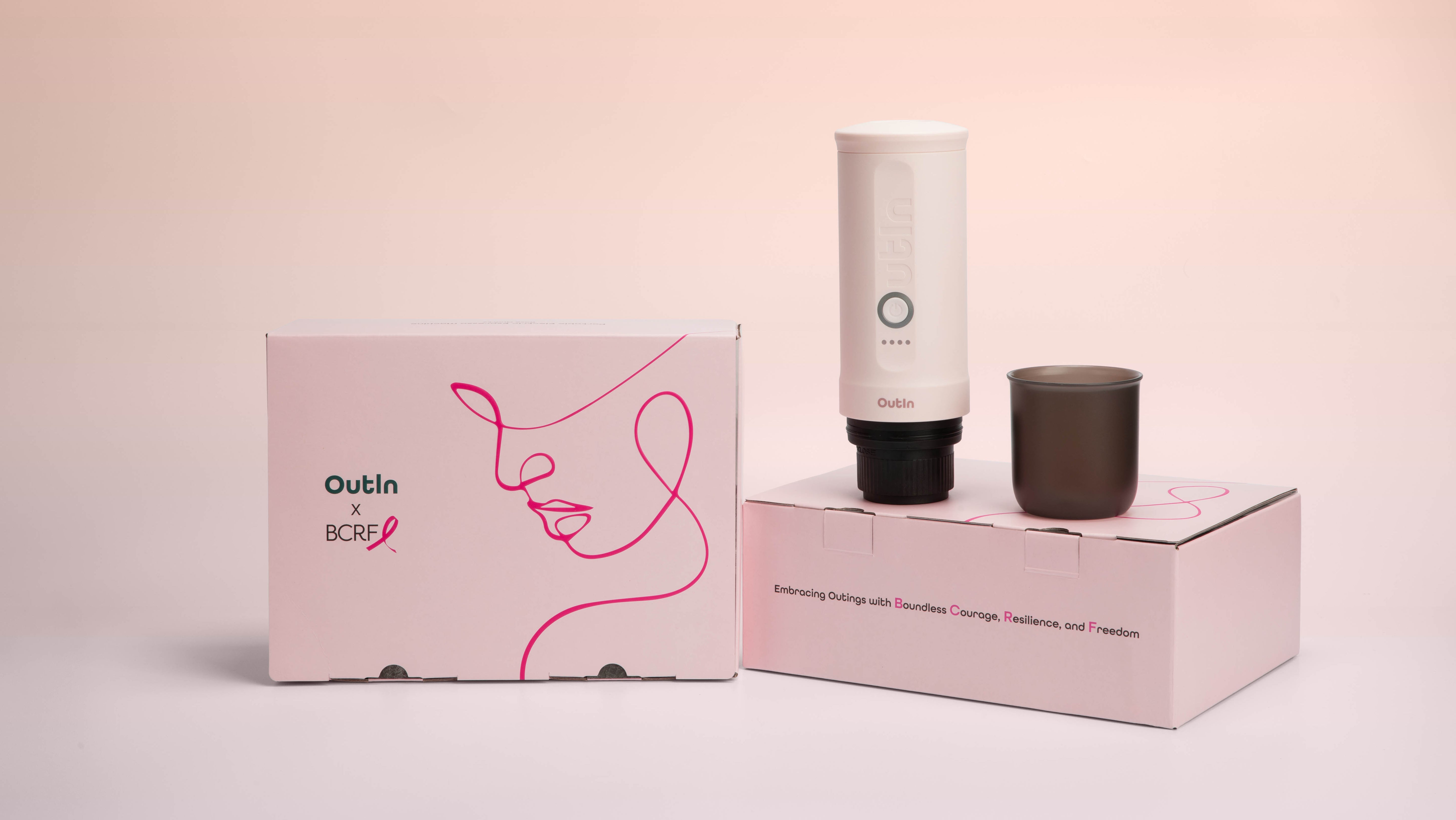커피 애호가들은 중요한 선택을 해야 합니다: 통두콩과 분쇄 커피? 이 결정은 맛, 사용 편의성, 그리고 전체적인 양조 경험에 영향을 미칩니다. 통두콩은 가장 신선하고 개인화된 반면, 분쇄 커피는 바로 사용할 수 있는 편의성을 제공합니다.
이 가이드에서는 이러한 선택 사항을 대조하여 혜택과 단점, 재정적 및 환경적 영향을 살펴보겠습니다. 선호도와 생활 방식에 맞는 이상적인 커피 형태를 선택하는 데 필요한 모든 지식을 갖추게 될 것입니다.

커피콩의 기본
커피콩은 기반 모든 훌륭한 양조의. 그 종류, 원산지, 가공 기술, 로스팅 특성은 모두 완성된 컵의 특성에 영향을 미칩니다.
커피콩의 기원
커피를 생산하는 식물은 다음과 같은 지역에서 번성합니다. 열대 또는 아열대, 주로 "커피 벨트"에 있습니다. 이 지역에는 적도에 가까운 국가, 예를 들어 동남아시아, 본부 그리고 남아메리카, 그리고 아프리카의 일부. 토양의 구성, 키, 그리고 기후각 장소마다 콩의 특징이 다릅니다.
커피콩의 종류
두 가지 주요 종 세계 커피 생산을 지배하다:
- 아라비카: 약 60% 전 세계적으로 생산되는 커피의 의 는 이 원두에서 나옵니다. 부드럽고 미묘한 맛으로 존경받는 아라비카 식물은 더 높은 고도에서 번성하며 경쟁자보다 카페인이 적은 원두를 생산합니다.
- 로부스타: 로부스타 원두에는 더 강하다, 종종 쓴맛이 난다 그리고 더 단단하고 카페인 함량이 더 높습니다. 인스턴트 커피 제품과 에스프레소 블렌드에서 흔히 발견됩니다.
처리 방법
수확 후, 커피 체리는 콩을 추출하기 위해 가공 과정을 거칩니다.
- 세척(습식) 공정: 과일 제거는 콩을 건조하기 전에 이루어집니다. 그 결과는 다음과 같습니다. 더 깨끗한 맛 이는 콩의 고유한 풍미를 강조합니다.
- 자연(건식) 공정: 커피 체리 전체가 콩과 함께 건조됩니다. 이 방법은 최종 제품에 더 풍부한 바디와 더 달콤하고 과일 같은 노트를 부여합니다.
- 꿀 가공 과정: 하이브리드 방식은 건조하는 동안 콩에 약간의 과일을 남겨둡니다. 그 결과 세척 및 자연 공정 사이의 균형 잡힌 풍미 프로필이 만들어집니다.
로스팅 프로필
로스팅은 생두를 향기로운 갈색 커피콩으로 변형합니다. 로스트 수준은 풍미에 상당한 영향을 미칩니다.
- 라이트 로스트: 표면에 기름이 없고 연한 갈색을 띠는 원두는 커피 본래의 풍미를 대부분 유지하는데, 종종 밝고 신맛이 난다고 묘사됩니다.
- 중간 로스트: 약간 더 진한 원두는 균형 잡힌 맛, 향, 산미를 제공합니다. 다재다능해서 인기 있는 선택입니다.
- 다크 로스트: 가장 어두운 콩은 윤기 있고 기름진 표면을 특징으로 합니다. 산도가 낮아 대담하고 풍부한 풍미를 보이며, 종종 초콜릿이나 카라멜 향이 납니다.
원두커피를 선택하든 분쇄커피를 선택하든, 이러한 기본 사항을 고려하면 취향에 맞는 원두를 선택할 수 있습니다.

원두 커피
많은 커피 애호가들에게 분쇄 커피는 실용적인 선택입니다. 많은 소비자들에게 양조 경험은 생산 방법, 이점 및 가능한 단점에 따라 형성됩니다.
설명 및 제작
분쇄 커피는 볶은 커피 원두를 기계적으로 분쇄하여 작은 입자로 만든 것입니다.산업용 분쇄기는 양조 기술의 종류에 따라 전체 원두를 다양한 수준의 미세함으로 분쇄합니다. 그 후, 완제품은 판매 및 유통을 위해 포장됩니다.
원두 커피의 장점
1. 편리함과 시간 절약:
미리 분쇄된 커피는 집에서 분쇄하는 일이 없습니다. 사용자는 원하는 양을 측정하고 바로 양조 과정을 시작하여 아침 일과와 커피 준비를 간소화합니다.
2. 크기와 맛의 일관성:
상업용 그라인더는 일정한 크기의 입자를 생성하기 때문에 추출과 풍미가 양조 과정 내내 일정하게 보장됩니다. 특히 커피를 처음 만드는 사람들은 이로부터 이익을 얻습니다. 일률.
3. 접근성 및 다양성:
분쇄 커피는 슈퍼마켓과 전문점에서 널리 구할 수 있습니다. 다양한 맛, 믹스, 그리고 로스트 강도 전문적인 도구가 필요 없이 다양한 취향을 만족시킬 수 있습니다.
원두 커피의 단점
1. 신선도와 향의 손실:
분쇄된 커피의 방향족 화합물은 빠르게 사라지기 시작합니다. 통두콩과 비교했을 때, 맛의 저하가 더 빨리 일어난다 공기에 더 많이 노출되는 표면에서.
2. 제한된 그라인드 크기 사용자 정의:
미리 갈은 커피는 일반적으로 단일 분쇄 크기 패키지로 제공됩니다. 이러한 제한으로 인해 다양한 양조 기술에 최적화하기가 더 어려울 수 있습니다. 다른 방법은 더 거친 분쇄가 필요한 반면, 에스프레소 머신은 더 고운 분쇄가 필요합니다고정된 분쇄 크기가 모든 기계와 호환되지 않으면 양조 품질이 떨어질 수 있습니다.
3. 외부 요인에 대한 취약성:
분쇄 커피는 환경 요인에 더 취약합니다. 빛, 습기, 산소에 노출되면 모두 풍미 품질에 큰 영향을 미칠 수 있습니다. 통두는 적절한 보관보다 보관 기간이 더 깁니다.

통두콩 커피
가장 순수한 형태의 통두 커피는 커피의 모든 자연적 특성을 유지합니다. 적응성 그리고 가능성 더 나은 맛을 위해 커피 마시는 사람들은 종종 이 대안을 선택합니다.
설명 및 특성
통두 커피는 분해되지 않은 볶은 커피콩으로 만들어집니다. 양조를 위해 가공될 때까지 이 콩은 원래의 맛을 유지합니다. 내재 오일, 향기로운 성분, 그리고 구조.
통두콩 커피의 장점
1. 신선도 및 풍미 유지:
미리 갈은 커피에 비해 통두는 풍미 특성을 더 오래 유지합니다. 모든 잔에 가장 많은 풍미와 향이 있도록 하려면 양조 직전에 갈아주세요.
2. 분쇄 크기의 유연성:
사용자는 다양한 양조 기술에 맞게 분쇄 크기를 수정할 수 있습니다. 거친 분쇄는 미세 분쇄보다 프렌치 프레스에 더 적합하여 더 많은 실험과 최적화가 가능합니다. 미세한 분쇄는 에스프레소 머신에 이상적입니다..
3. 더 긴 유통기한:
통 커피콩은 분쇄 커피보다 변질에 더 강합니다. 시간이 지남에 따라 적절한 보관은 몇 주 또는 몇 달 동안 신선도를 유지하여 더 높은 가치를 제공할 수 있습니다.
통두콩 커피의 단점
1. 추가 장비 필요성:
그라인더는 통두 커피를 추출하는 데 필요합니다. 이러한 필요성으로 인해 초기 가격과 카운터 공간 요구 사항이 증가합니다.
2. 추가 시간과 노력:
이제 커피를 준비하려면 한 단계 더 필요합니다. 바로 분쇄 과정입니다.이러한 추가 시간은 바쁜 일정을 가지고 있는 사람이나 즉각적인 커피 섭취가 필요한 사람들에게는 불편을 줄 수 있습니다.
3. 잠재적 불일치:
일정한 분쇄 크기를 얻으려면 연습과 고품질 도구가 필요합니다. 분쇄의 변화는 추출의 불균형을 초래할 수 있으며, 이는 양조의 맛 균형과 품질에 영향을 미칠 수 있습니다.
원두커피는 더 뛰어난 맛과 제어력을 가질 수 있는 잠재력이 있지만, 더 많은 시간 그리고 장비 준비하다.

원두커피와 통두커피를 선택하는 핵심 요소
통두콩과 분쇄 커피 중에서 선택할 때 다음 사항을 명심하세요.
1. 맛 신선함
개봉 후, 분쇄된 커피는 맛이 빨리 사라지고 1~2주 동안만 지속됩니다. 적절하게 보관하면 통콩은 로스팅 후 2~4주 동안 맛을 유지합니다. 통콩을 사용하는 것이 더 좋습니다 가장 순수한 맛을 원하신다면.
2. 양조 장비 호환성
특정 커피 머신은 특정 분쇄로 더 효과적입니다. 미리 분쇄된 중간 크기의 커피는 드립 커피 머신에서 잘 작동합니다. 분쇄를 머신에 맞게 수정할 수 있기 때문에 전체 원두는 다음을 포함한 에스프레소 머신에 더 바람직한 옵션입니다. 휴대용 에스프레소 머신, 매우 고운 신선한 분쇄가 필요합니다. 거친 분쇄는 프렌치 프레스에 필요하며 사전 분쇄된 선택에서는 덜 빈번합니다.
3. 시간과 편의성
분쇄된 커피는 다음 후에 사용할 수 있습니다. 3~5분 양조의. 사용하기 전에 전체 콩을 갈아야 합니다. 준비 시간이 1~2분 더 길어짐아침에 어떻게 커피를 만들고 얼마나 많은 시간이 있는지 생각해보세요.
4. 주방 공간 요구 사항
분쇄 커피 패키지에는 보관 공간만 있으면 됩니다. 통원두와 분쇄기를 위한 공간이 있어야 합니다. 일반적으로 전기 분쇄기는 6 x 6인치의 카운터 공간이 필요합니다. 선택할 때, 사용 가능한 주방 공간의 양을 고려하세요.
5. 비용 고려 사항
처음에는 분쇄 커피가 종종 덜 비쌉니다. 12온스 봉지는 보통 $8-$15입니다. 통두는 12온스 봉지당 $10에서 $20 사이이고, 분쇄기는 $20에서 $200 이상까지 비쌉니다. 결정을 내릴 때 이러한 비용을 고려하세요.
6. 필요한 기술 수준
분쇄된 커피는 측정하고 사용하기 쉽습니다. 통두콩은 분쇄 크기가 적절하기 때문에 분쇄하는 법을 배워야 합니다. 맛에 상당한 영향을 끼친다. 커피 제조에 대한 새로운 기술을 배우려는 의지를 고려하세요.
7. 다양성과 가용성
대부분 소매업체는 다양한 맛과 로스트에 분쇄 커피를 제공합니다. 통두는 일반 매장에서는 선택 사항이 적을 수 있지만, 스페셜티 커피 카페에서는 더 다양한 종류를 제공합니다. 일반적인 커피숍과 이용 가능한 옵션을 고려하세요.
커피 선택의 환경적 영향과 지속 가능성
분쇄된 커피와 통두콩 중에서 선택하는 것은 커피 추출뿐만 아니라 환경에도 영향을 미칩니다.
1. 포장 폐기물
분쇄 커피는 신선함을 유지하기 위해 종종 작고 일회용 포장으로 판매됩니다. 이로 인해 더 많은 폐기물이 발생할 수 있습니다. 통두는 일반적으로 더 큰 봉지에 담겨 제공되므로 전체적으로 포장이 줄어듭니다. 일부 브랜드는 두 유형 모두에 재활용 가능하거나 퇴비화 가능한 포장을 사용합니다. 어떤 재료를 사용할 수 있는지 확인하세요. 재활용하다 귀하가 사는 지역에서 친환경적인 선택을 할 수 있도록 도와주세요.
2. 분쇄에서의 에너지 사용
대형 공장은 가정용 분쇄기보다 더 효율적으로 커피를 분쇄합니다. 그러나 집에서 커피를 분쇄하는 데 사용되는 에너지는 매우 적습니다.에너지를 절약하고 싶다면 통콩을 분쇄하는 수동 분쇄기를 사용할 수 있습니다.
3. 커피 소싱
분쇄 커피와 통두콩은 모두 환경과 농부에게 좋은 방식으로 재배되고 구매될 수 있습니다. 다음과 같은 라벨을 찾아보세요. 공정 무역, 열대우림연합, 또는 직접 거래. 이는 커피가 더 나은 농사 관행으로 만들어졌고 농부들이 공정한 급여를 받았다는 것을 의미합니다. 통두콩 패키지는 종종 커피가 어디에서 왔는지에 대한 더 많은 정보를 제공합니다.
4. 커피를 만드는 과정에서 나오는 폐기물
커피를 만드는 방법은 분쇄 커피나 통두콩을 사용하는지보다 폐기물에 더 큰 영향을 미칩니다. 두 종류 모두 사용한 찌꺼기를 남깁니다. 이 땅은 퇴비화될 수 있습니다어떤 종류를 선택하든 사용한 커피 찌꺼기를 퇴비화하는 것을 고려하세요.
커피를 선택하세요!
완벽한 커피 선택은 당신에게 가장 중요한 것에 따라 달라집니다. 분쇄 커피는 빠르고 쉬운 반면, 통두는 더 신선한 맛과 더 많은 제어력을 제공합니다. 당신의 취향 선호도, 시간, 커피 메이커, 예산을 고려하세요. 또한 당신의 선택이 환경에 어떤 영향을 미치는지 고려하세요. 두 가지 옵션을 모두 시도하여 가장 마음에 드는 것을 확인하세요. 올바른 선택은 당신의 라이프스타일에 맞고 매일 즐길 수 있는 커피 한 잔을 제공하는 것입니다.




댓글을 남겨주세요
이 사이트는 hCaptcha에 의해 보호되며, hCaptcha의 개인 정보 보호 정책 과 서비스 약관 이 적용됩니다.